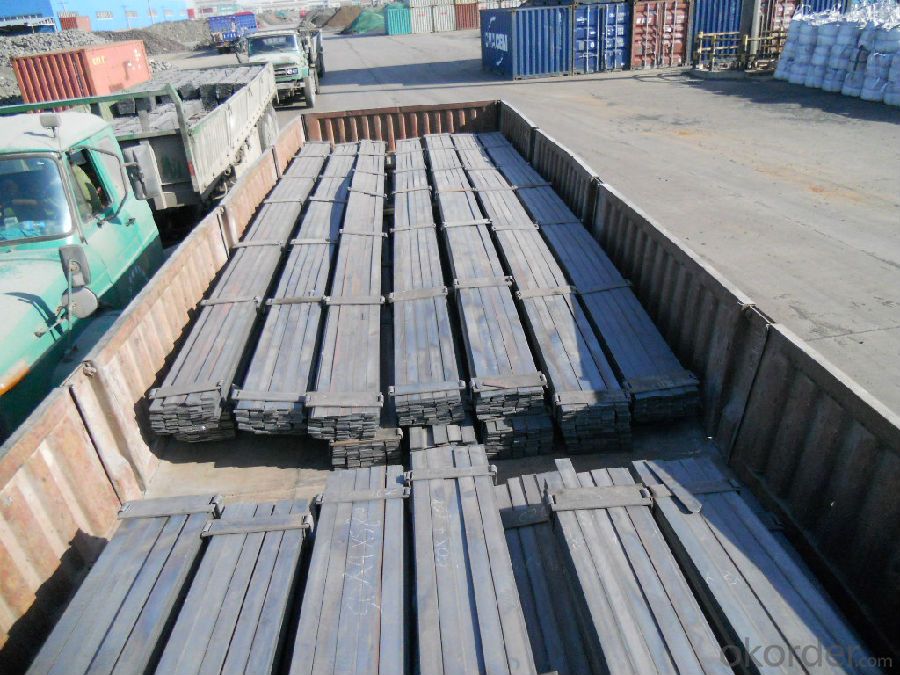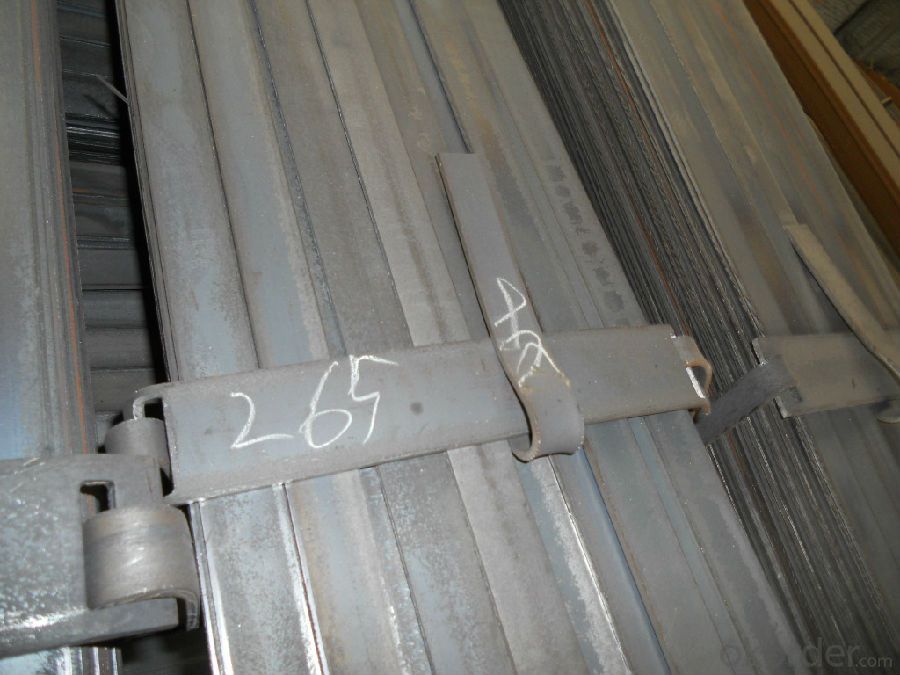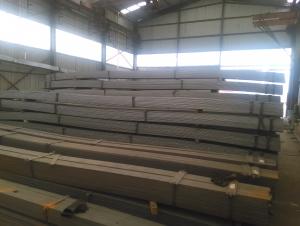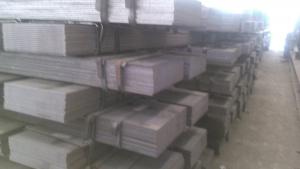GB Standard Steel Flat Bar with High Quality 45mm
- Loading Port:
- Tianjin
- Payment Terms:
- TT OR LC
- Min Order Qty:
- 25 m.t
- Supply Capability:
- 15000 m.t/month
OKorder Service Pledge
OKorder Financial Service
You Might Also Like
Product Description of GB Standard Steel Flat Bar with High Quality 45mm:
Specification of GB Standard Steel Flat Bar with High Quality 45mm:
-Standard: GB
-Material: Q235
-Length: 6m, 12m
-Size:
Size(mm) | Mass(Kg/m) |
45*5 | 1.77 |
45*8 | 2.82 |
45*10 | 3.53 |
Package & Delivery of GB Standard Steel Flat Bar with High Quality 45mm:
1.The steel flat bars will be packed in bundle with steel wire at each end of every bundle and color marking in order to help the customer to recognize his goods more easily at sight.
2. And the steel flat bars could be loaded into 20ft or 40ft container, or by bulk cargo. If the weight of each bundle reaches more than 3.5 mt, the loading by break bulk cargo should be choosed. When the weight of each bundle reaches less than 3mt, the loading by container should be choosed.
3.As for the transportaion from mill to loading port, the truck will be usually used. And the maximum quantity for each truck is 40mt.
4.All in all, we could do in accordance with customer's request.
FAQ:
Q1: Why buy Materials & Equipment from OKorder.com?
A1: All products offered by OKorder.com are carefully selected from China's most reliable manufacturing enterprises. Through its ISO certifications, OKorder.com adheres to the highest standards and a commitment to supply chain safety and customer satisfaction.
Q2: How do we guarantee the quality of our products?
A2: We have established an advanced quality management system which conducts strict quality tests at every step, from raw materials to the final product. At the same time, we provide extensive follow-up service assurances as required.
Q3: How soon can we receive the product after purchase?
A3: Within three days of placing an order, we will arrange production. The shipping date is dependent upon the quatity, how many sizes you want and the plan of production, but is typically 1 month to 2 month days from the beginning of production.
Images of GB Standard Steel Flat Bar with High Quality 45mm:


*If you would like to get our price, please inform us the size, standard/material and quantity. Thank you very much for your attention.
- Q:Are steel flat bars suitable for outdoor signage or display structures?
- Yes, steel flat bars are suitable for outdoor signage or display structures. Steel is a durable and strong material that can withstand various weather conditions, making it ideal for outdoor applications. Steel flat bars provide stability and support, making them suitable for creating sturdy signage or display structures that can withstand wind, rain, and other environmental elements. Additionally, steel can be easily fabricated and customized to meet specific design requirements, allowing for versatile and visually appealing outdoor displays.
- Q:How can copper cables and flat steel be welded together?
- The copper cable is pressed into the nose. It is punched through the steel and screwed,The national standard atlas is connected with a total equipotential terminal box.
- Q:What are the common load-bearing capacities of steel flat bars?
- The common load-bearing capacities of steel flat bars vary depending on their dimensions and specific grade of steel. However, typical load-bearing capacities range from a few hundred pounds to several thousand pounds. It is advisable to consult engineering manuals or professionals for precise load-bearing capacity information based on the specific flat bar dimensions and steel grade.
- Q:Can steel flat bars be used for manufacturing conveyor systems?
- Conveyor systems can indeed be manufactured using steel flat bars. These bars, renowned in the construction sector for their robustness, longevity, and adaptability, are frequently employed for this purpose. Their exceptional qualities render them suitable for a broad range of applications, including the production of conveyor systems. Within these systems, steel flat bars can serve as supports, frames, or guide rails, guaranteeing steadfastness and facilitating the seamless transportation of materials. Furthermore, steel exhibits remarkable resistance to corrosion, a particularly crucial attribute in environments where moisture or chemicals may come into contact with the conveyor system. In sum, steel flat bars represent a dependable and highly effective choice for the manufacture of conveyor systems.
- Q:What are the different methods of joining steel flat bars?
- The different methods of joining steel flat bars include welding, bolting, riveting, and using adhesive bonding.
- Q:Can steel flat bars be used for making tools or toolboxes?
- Yes, steel flat bars can be used for making tools or toolboxes. Steel flat bars are strong, durable, and resistant to corrosion, making them an ideal material for constructing tools. They can be shaped, cut, and welded to create various types of tools such as wrenches, hammers, and screwdrivers. Additionally, steel flat bars can be used to fabricate toolboxes due to their structural integrity and ability to withstand heavy loads. Overall, steel flat bars are a versatile material that can be effectively utilized in the construction of tools and toolboxes.
- Q:What are the different bending techniques for steel flat bars?
- Steel flat bars can be bent using various techniques depending on the desired shape and project requirements. The most commonly used bending techniques for steel flat bars are as follows: 1. Cold Bending: This technique involves gradually bending the bar at room temperature using manual or mechanical presses, or bending machines. It is the most widely used method. 2. Hot Bending: Another technique is hot bending, which involves heating the bar to a high temperature to increase its malleability before shaping it. Furnaces or torches are typically used for heating. 3. Roll Bending: This technique requires passing the steel flat bar through a series of rollers to achieve the desired shape. It is commonly used for large-scale projects and can be done manually or with specialized machinery. 4. Mandrel Bending: In this technique, a solid rod or tube called a mandrel is inserted into the steel flat bar to provide support and prevent deformation during bending. It is often used for small radius bends or complex shapes. 5. Press Brake Bending: Press brake machines are employed in this technique to apply pressure and bend the steel flat bar. A punch and die are used to form the desired bend. It is important to consider factors such as the size, thickness, and bend radius of the steel flat bar, as well as the specific project requirements when choosing a bending technique. Consulting with a professional or metal fabrication expert is recommended to determine the most suitable technique for a particular application.
- Q:What is the maximum length-to-thickness ratio for a steel flat bar?
- Industry standards and engineering specifications typically determine the maximum permissible length-to-thickness ratio for a steel flat bar. Generally, it is recommended to maintain a length-to-thickness ratio of around 160:1, which means that the bar's length can be up to 160 times its thickness. Nevertheless, it is crucial to understand that this maximum ratio may vary depending on the specific application and intended use of the steel flat bar. Different industries and engineering disciplines may establish their own guidelines and recommendations for maximum length-to-thickness ratios, taking into account factors such as load-bearing capacity, structural stability, and safety considerations. To determine the appropriate maximum length-to-thickness ratio for a steel flat bar, it is always advisable to refer to relevant codes, standards, and engineering guidelines specific to the application. Seeking the expertise of professional engineers and experts in the field can provide valuable insights and calculations, ensuring the structural integrity and safety of the steel flat bar in a given application.
- Q:What are the different specifications for steel flat bars?
- Steel flat bars can have different specifications depending on their dimensions, such as width, thickness, and length. They can vary in width, ranging from 1/8 inch to several inches, and thickness, ranging from 1/8 inch to 1 inch or more. Lengths can also vary, commonly found in standard sizes of 8, 10, or 20 feet, but can be customized as well. Additionally, steel flat bars can have different grades or types of steel, such as carbon steel or stainless steel, which can affect their strength and corrosion resistance properties.
- Q:The difference between galvanized flat steel 40*4 and galvanized flat steel 80*8 is the difference on the material list!
- There are many kinds of flat steel, Q235A/B/C, mainly depends on the location of your specific requirements, what is needed?;
1. Manufacturer Overview |
|
|---|---|
| Location | |
| Year Established | |
| Annual Output Value | |
| Main Markets | |
| Company Certifications | |
2. Manufacturer Certificates |
|
|---|---|
| a) Certification Name | |
| Range | |
| Reference | |
| Validity Period | |
3. Manufacturer Capability |
|
|---|---|
| a)Trade Capacity | |
| Nearest Port | |
| Export Percentage | |
| No.of Employees in Trade Department | |
| Language Spoken: | |
| b)Factory Information | |
| Factory Size: | |
| No. of Production Lines | |
| Contract Manufacturing | |
| Product Price Range | |
Send your message to us
GB Standard Steel Flat Bar with High Quality 45mm
- Loading Port:
- Tianjin
- Payment Terms:
- TT OR LC
- Min Order Qty:
- 25 m.t
- Supply Capability:
- 15000 m.t/month
OKorder Service Pledge
OKorder Financial Service
Similar products
New products
Hot products
Related keywords




























